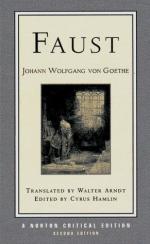[D] Life of Goethe (Book VI.).
[E] Mr. Lewes gives the following advice: “The English reader would perhaps best succeed who should first read Dr. Anster’s brilliant paraphrase, and then carefully go through Hayward’s prose translation.” This is singularly at variance with the view he has just expressed. Dr. Anster’s version is an almost incredible dilution of the original, written in other metres; while Hayward’s entirely omits the element of poetry.
[F] Foreign Review, 1828.
[G] When Freiligrath can thus give us Walter Scott:—
“Kommt, wie der Wind kommt, Wenn Waelder erzittern Kommt, wie die Brandung Wenn Flotten zersplittern! Schnell heran, schnell herab, Schneller kommt Al’e!—Haeuptling und Bub’ und Knapp, Herr und Vasalle!”
or Strodtmann thus reproduce Tennyson:—
“Es faellt der Strahl auf Burg und Thal, Und schneeige Gipfel, reich an Sagen; Viel’ Lichter wehn auf blauen Seen, Bergab die Wasserstuerze jagen! Blas, Huefthorn, blas, in Wiederhall erschallend: Blas, Horn—antwortet, Echos, hallend, hallend, hallend!”
—it must be a dull ear which would be satisfied with the omission of rhythm and rhyme.
I have a more serious objection, however, to urge against Mr. Hayward’s prose translation. Where all the restraints of verse are flung aside, we should expect, at least, as accurate a reproduction of the sense, spirit, and tone of the original, as the genius of our language will permit. So far from having given us such a reproduction, Mr. Hayward not only occasionally mistakes the exact meaning of the German text,[H] but, wherever two phrases may be used to express the meaning with equal fidelity, he very frequently selects that which has the less grace, strength, or beauty.[I]
[H] On his second page, the line Mein Lied ertoent der unbekannten Menge, “My song sounds to the unknown multitude,” is translated: “My sorrow voices itself to the strange throng.” Other English translators, I notice, have followed Mr. Hayward in mistaking Lied for Leid.
I:
I take but one out of numerous instances, for
the sake of
illustration. The close of the Soldier’s
Song (Part I. Scene II.) is:—




